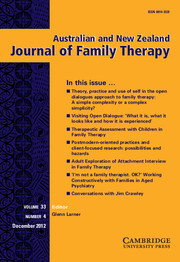Crossref Citations
This article has been cited by the following publications. This list is generated based on data provided by
Crossref.
Angel, Caroline M.
Sherman, Lawrence W.
Strang, Heather
Ariel, Barak
Bennett, Sarah
Inkpen, Nova
Keane, Anne
and
Richmond, Therese S.
2014.
Short-term effects of restorative justice conferences on post-traumatic stress symptoms among robbery and burglary victims: a randomized controlled trial.
Journal of Experimental Criminology,
Vol. 10,
Issue. 3,
p.
291.
Gee, Donna
Mildred, Helen
Brann, Peter
and
Taylor, Mandy
2015.
Brief Intervention: A Promising Framework for Child and Youth Mental Health?.
Administration and Policy in Mental Health and Mental Health Services Research,
Vol. 42,
Issue. 2,
p.
121.
Al-khatib, Batul
and
Norris, Sarah
2015.
A Family Consultation Service: Single session intervention to build the mental health and wellbeing of children and their families.
Educational and Child Psychology,
Vol. 32,
Issue. 4,
p.
7.
Pitt, Tim
Lindsay, Pete
Thomas, Owen
Bawden, Mark
Goodwill, Simon
and
Hanton, Sheldon
2015.
A perspective on consultancy teams and technology in applied sport psychology.
Psychology of Sport and Exercise,
Vol. 16,
Issue. ,
p.
36.
Nieuwboer, Christa C.
Fukkink, Ruben G.
and
Hermanns, Jo M.A.
2015.
Single session email consultation for parents: an evaluation of its effect on empowerment.
British Journal of Guidance & Counselling,
Vol. 43,
Issue. 1,
p.
131.
Pitt, Tim
Thomas, Owen
Lindsay, Pete
Hanton, Sheldon
and
Bawden, Mark
2015.
Doing sport psychology briefly? A critical review of single session therapeutic approaches and their relevance to sport psychology.
International Review of Sport and Exercise Psychology,
Vol. 8,
Issue. 1,
p.
125.
Bloom, Kathleen
and
Tam, Jane A.
2015.
Walk-in Services for Child and Family Mental Health.
Journal of Systemic Therapies,
Vol. 34,
Issue. 1,
p.
61.
Thell, Nataliya
and
Jacobsson, Katarina
2016.
“And how old are you?”: Age reference as an interpretative device in radio counselling.
Journal of Aging Studies,
Vol. 39,
Issue. ,
p.
31.
Stalker, Carol A.
Riemer, Manuel
Cait, Cheryl-Anne
Horton, Susan
Booton, Jocelyn
Josling, Leslie
Bedggood, Joanna
and
Zaczek, Margaret
2016.
A comparison of walk-in counselling and the wait list model for delivering counselling services.
Journal of Mental Health,
Vol. 25,
Issue. 5,
p.
403.
Mutter, Kelvin F.
2016.
Encyclopedia of Psychology and Religion.
p.
1.
Paprocki, Christine M.
and
Baucom, Donald H.
2017.
Worried About us: Evaluating an Intervention for Relationship‐Based Anxiety.
Family Process,
Vol. 56,
Issue. 1,
p.
45.
Binfet, John-Tyler
2017.
The Effects of Group-Administered Canine Therapy on University Students’ Wellbeing: A Randomized Controlled Trial.
Anthrozoös,
Vol. 30,
Issue. 3,
p.
397.
Coates, Dominiek
and
Howe, Deborah
2017.
Improving throughput in a youth mental health service.
International Journal of Health Care Quality Assurance,
Vol. 30,
Issue. 3,
p.
224.
Schleider, Jessica L.
and
Weisz, John R.
2017.
Little Treatments, Promising Effects? Meta-Analysis of Single-Session Interventions for Youth Psychiatric Problems.
Journal of the American Academy of Child & Adolescent Psychiatry,
Vol. 56,
Issue. 2,
p.
107.
Akerele, Evaristo
and
Yuryev, Andriy
2017.
Single session psychotherapy for humanitarian missions.
International Journal of Mental Health,
Vol. 46,
Issue. 2,
p.
133.
O'Neill, Imogen
2017.
What's in a name? Clients’ experiences of single session therapy.
Journal of Family Therapy,
Vol. 39,
Issue. 1,
p.
63.
Wagner, Giorgia A.
Mildred, Helen
Gee, Donna
Black, Emma B.
and
Brann, Peter
2017.
Effectiveness of brief intervention and case management for children and adolescents with mental health difficulties.
Children and Youth Services Review,
Vol. 79,
Issue. ,
p.
362.
Matthews, Kristin M.
2018.
The Integration of Emotion-Focused Therapy within Single-Session Therapy.
Journal of Systemic Therapies,
Vol. 37,
Issue. 4,
p.
15.
Eade, Donna M.
Telfer, Michelle M.
and
Tollit, Michelle A.
2018.
Implementing a Single-Session Nurse-Led Assessment Clinic into a Gender Service.
Transgender Health,
Vol. 3,
Issue. 1,
p.
45.
Aafjes-van Doorn, Katie
and
Sweeney, Kristen
2019.
The effectiveness of initial therapy contact: A systematic review.
Clinical Psychology Review,
Vol. 74,
Issue. ,
p.
101786.




